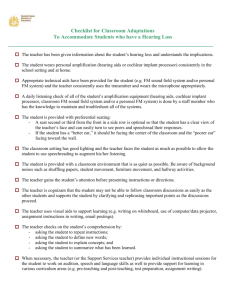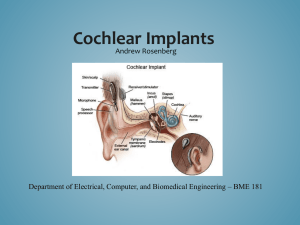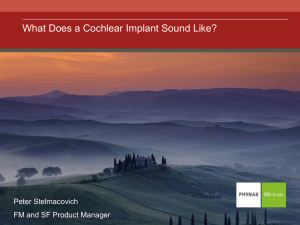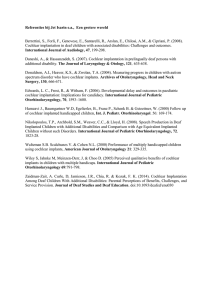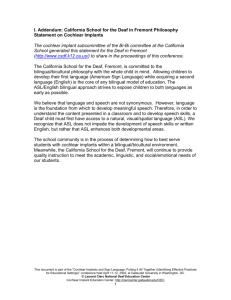J. by
advertisement
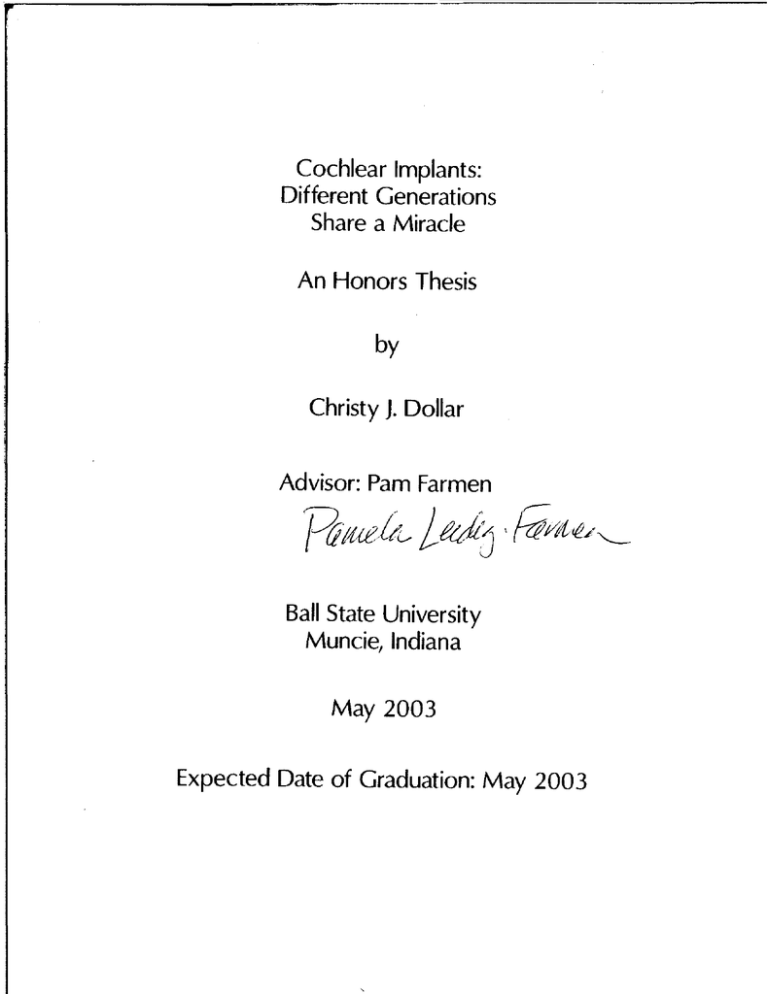
Cochlear Implants: Different Generations Share a Miracle An Honors Thesis by Christy J. Dollar Advisor: Pam Farmen Ffttue!/~ Lt«kj ,fin;[~~',Ball State University Muncie, Indiana May 2003 Expected Date of Graduation: May 2003 Abstract The completion of "Cochlear Implants: Different Generations Share a Miracle" brings journalism, photography, design, and audio together in an interactive multimedia presentation. The presentation tells three separate success stories of cochlear implant recipients. Each story consists of a slide show of still photographs accompanied by audio clips from interviews conducted with each recipient. Viewers can control the show by clicking on stop, play, rewind and main buttons. The emphasis of this project is the positive impact cochlear implants have on recipients of different generations. Not only is this a personal interest story, but it is also educational and informative for viewers. Hearing is something that many people take for granted. These individual's stories encourage the viewer with normal hearing to think about how precious and valuable the sense of hearing is. Conversely, these stories can give hope and information to those who are hearing impaired. Acknowledements I would like to thank.. .. <Pam Farmen for being a helpful and willing advisor for my honors thesis. She has been encouraging throughout this project and throughout my educational journey at Ball State. <Jennifer George-Palilonis for being a remarkable professor and sharing her knowledge of journalism and design. My design skills have not only assisted me in my honors thesis, but they have also provided me with a career in newspaper design. <Larry Dailey for introducing me to interactive multimedia presentations and for being patient enough to teach me the basics of Flash. Without his training and guidance this project would have been a nightmare to execute. <All three of the cochlear implant recipients that were kind enough to share their story with me. Wayne Ostrander, Leanna Ernst, and William Frentz were extremely wonderful to work with and cooperative in the making of my thesis project. I was fortunate enough to learn about the value of hearing from these three individuals. <Peg Barry for taking the time to tell me about her job as a cochlear implant specialist. She provided me with an abundance of information on the topic along with reading materials about the implants. Her expertise helped me immensely in completing the research for this project. <Beth Carby for her assistance in collecting, editing, and digitizing audio. She was extremely helpful with technical and conceptual processes. She also provided me with the contacts and base information for completing this project. <The Honors College for the opportunity to complete a thesis which allowed me to exercise my creative and technical abilities in the area of journalistic design. My honors experience as a whole has been a challenging and unique addition to my college career at Ball State. Cochlear Implants: Different Generations Share a Miracle by Christy Dollar Choices and Challenges "Cochlear Implants: Different Generations Share a Miracle" was executed through a series of choices and challenges. First, the choice to present three stories was made in order to tell different perspectives from different generations. I wanted to show the implant experience through the eyes of a young child, a teenager, and an adult. This gives the viewer a higher chance to relate to one of the recipients through age similarity. The choice of presenting this information in an interactive slide show was made to give the viewer control over their experience. Using an audio element instead of text to accompany the photographs was done to give the story more accuracy and feeling. The specialist commentary button was used to provide viewers with background information on cochlear implants to better understand the recipients' stories and experiences. I included an acknowledgments button to give credit to those who helped me complete my honors thesis. I wanted viewers to know that a project like this takes help and assistance from all types of people with expertise in different skills. After thinking about all of these components, making all of these choices, and overcoming technical challenges, the result was the interactive storytelling presentation "Cochlear Implants: Different Generations Share a Miracle." Why cochlear implants? The use of the topic of cochlear implants was more of a coincidence than a choice. My roommate, Beth Carby, has a parent who works for a deaf school in Louisville, Kentucky. Paula Carby, Beth's mother, works with deaf infants and toddlers in this facility. Through these contacts and Beth's help, I happened upon the topic of cochlear implants. Paula Carby shared her knowledge of how cochlear implants have changed people's lives by giving them what nature couldn't-the ability to hear. Learning just a few facts about cochlear implants, I became extremely interested in the subject. A little device that allows deaf people to hear their own voice along with everyday sounds is an extremely powerful invention. Realizing how much of an impact cochlear implants have on a person's life, I decided to devote my honors thesis to this topic. The Cochlear Implant: A Small Miracle An estimate of two million Americans cannot participate in everyday conversation or use the telephone due to profound hearing loss. In the early 1970's cochlear implants started providing these people with a technological alternative to nature's sense of hearing. Over the years, cochlear implants have improved so much that now most implant recipients are able to carry on conversations and hear everyday sounds they never thought they would be able to hear (Advanced Bionics Corporation). Cochlear implants have external and internal parts. The internal parts are surgically implanted under the skin. A microphone, a speech processor, and a transmitter make up the external parts. The microphone picks up sounds and carries them to the speech processor. The receiver and electrodes make up the implanted or internal parts. The receiver is behind the ear under the skin. It takes the signals from the transmitter and carries them to the electrodes that have been implanted into the cochlea. The electrodes stimulate the auditory nerve and the brain translates it as sound (American Speech-Language-Hearing Association). In actual time, this process 2 happens so fast that the listener receives sound at the time it occurs (Advanced Bionics Corporation). Who qualifies for an implant? Cochlear implants are given to people who have profound hearing loss. Profound hearing loss for children 18 months or older is a loss greater than 90 decibels. For adults, profound hearing loss is a loss greater than 70 decibels. Most individuals with this much of a loss gain a small benefit from even the most powerful hearing aids. This hearing loss is caused by damaged hair cells in the cochlea (Advanced Bionics Corporation). The most common hearing loss is caused by damage to hair cells (Manning). When functioning normally, hair cells sway back and forth creating electrical impulses that are carried to the brain (Advanced Bionics Corporation). Benefits and Results There are over 70,000 cochlear implant recipients in the world and the number is rapidly growing. Of this 70,000, 28,000 are adults and children in the United States (Hear this Organization). After receiving cochlear implants, most adults talk on the phone, carry on conversations in person, have less social anxiety, and improve their interpersonal relationships. Children who receive implants have a much greater benefit due to the fact that communication and hearing is so important in early years of life. Children can start going to normal schools, communicate with other students, talk with their parents, and continue to learn at a normal rate after receiving implants (Advanced Bionics Corporation). Implants also have financial benefits. The cochlear implants cost from $30 3 to $60 thousand dollars whereas the cost to society of someone who has profound deafness from childhood through the rest of their life is predicted to be over $1 million dollars (Manning). Benefits for adults and children are explained and detailed in the stories told by the three implant recipients featured in the interactive multimedia presentation. Appreciative Conclusion After conducting research, interviewing cochlear implant recipients, taking photos of implants, and speaking with a specialist, not only did I learn about hearing loss and cochlear implants, I also learned to appreciate my sense of hearing. I met three different people who are extremely thankful for the cochlear implant. A person with normal hearing takes advantage of the fact that they can hear somebody call their name. I was fortunate enough to speak with people who have been moved to tears after hearing a clock tick. These three people know the true value of hearing because they received cochlear implants. 4 Works Cited Advanced Bionics Corporation. "Hearing Health." The Bionic Ear Association. URL: http://www.cochlearimplant.coml(2002). American Speech-Language-Hearing Association. "Cochlear Implant FAQs." URL: http://www .asha.orglhearing/rehab/cochieacimplant.cfm (2002). Barry, Peg. personal. 22 Feb. 2003. Ernst, Debbie. personal. 23 Feb. 2003. Frentz, Cindy. personal. 23 Feb. 2003. Frentz, William. personal. 23 Feb. 2003. Hear this Organization. "Hearing Loss is America's Invisible Disability." URL: http://www.hearthisorg.comlproblem_statement.htm (2002) Manning, Anita. "Implants Sounding Better." USA Today. URL: http://www.earsurgery.orglLhgen23l.htm (2 May 2(00). National Institute on Deafness and Other Communication Disorders. "Health Information." URL: http://www.nidcd.nih.gov/health/hearing/coch.asp (2 Dec. 2(02). Ostrander, Wayne. personal. 22 Feb. 2003. 5


